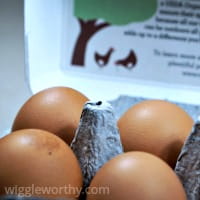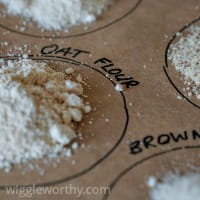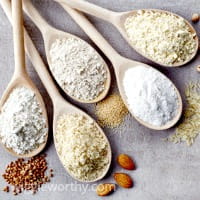Dog Treat Gluten Free Flour Blend
Using your own dog treat gluten free flour blend allows you to adapt a recipe which calls for wheat-based flour into gluten-free treats in a pretty straightforward way.
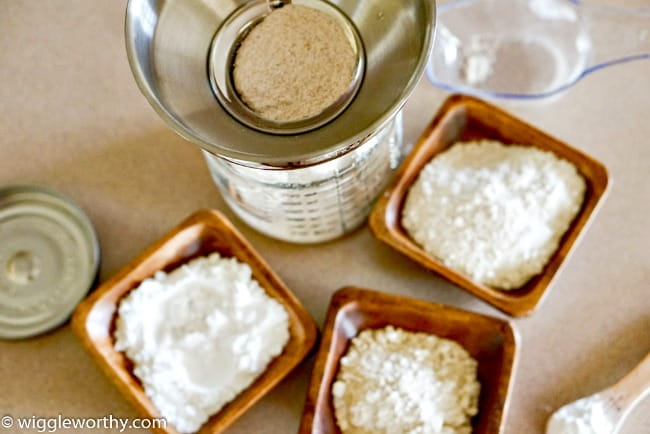
You can substitute your GF blend in a 1:1 ratio (ie one cup of your flour mix replaces one cup of whole wheat, or all purpose, flour).
- Basic how-to
- Best flours to use
- Creating whole grain and all-purpose blends
- Xanthan gum and other binders for gluten free baking
How to Make a Gluten Free Flour Mix
First of all, remember that whole wheat flour and all purpose flour are not the same, so you need one blend to replace whole wheat flour in a recipe and one to replace all purpose flour.
Once you understand the system I explain on this page you'll actually be able to create your own blends, using your favorite flours and allow for any intolerance or likes/dislikes you (or your dog) have.
The easiest way to create to your own dog treat gluten free flour blends:
- Divide flours for each option into two groups - whole grain or white flour/starch
- Decide on the percentage or ratio of one group to the other
It's really that simple and once you have those things in place you can create an almost endless variety of gluten-free flour mixes.
You can find a lot, and I mean a LOT of different ways to create gluten free flour blends online. Different flours, different ratios... it can be a bit overwhelming to be honest, but they're all valid! There's no one 'best way' to make a gluten free flour mix, there are simply lots of good (but different) ways.
Although I usually prefer to choose individual flours for each recipe (because it allows me to take into account the other ingredients as well overall taste and texture) I researched and experimented until I created a template for making gluten free blends using the flours that are best for dogs.
That is what I'm sharing with you on this page and I hope you find it helpful.
Which flours are best in a dog treat gluten free flour blend?
Research and experimentation resulted in these being the winners for me.
For each blend choose one, two or more flours from each category that add up to the percentage of the total flour in the recipe as shown.
Whole Wheat GF Flour Blend
|
Whole Grain (70%)
|
White/Starch (30%)
|
All-Purpose GF Flour Blend
|
Whole Grain (40%)
|
White/Starch (60%)
|
You can see there's a slight difference between the flour options for each type of blend. For me these are the most nutritious and dog-friendly flour options but feel free to be creative and experiment. There are lots of choices out there.
You'll also notice that although I do like using coconut and almond flour in my dog treat recipes, neither are on these lists. That's because nut flours in general behave differently in a recipe and you need to make more adjustments to existing ingredients for taste, texture etc. which doesn't make them a good choice for a generic GF flour blend.
If you do want to add some nut flour, or a bean flour, I've found that the best way to do it is to switch it out for a portion of the whole-grain flour/s that you're using in your blend. It can a bit hit-and-miss and you may need to adjust other ingredients a little (eg. coconut flour absorbs moisture like a sponge so you will need to increase the liquid in your recipe to allow for that).
You can find out more about substituting all types of gluten free flours here on my Baking Substitutions page.
Just FYI, although tapioca starch and tapioca flour are essentially the same and can be used interchangeably, potato starch and potato flour are not... and cannot.
Creating Your GF Flour Blends
You need a different ratio of whole grain flours to white flour/starches for each gluten free flour blend.
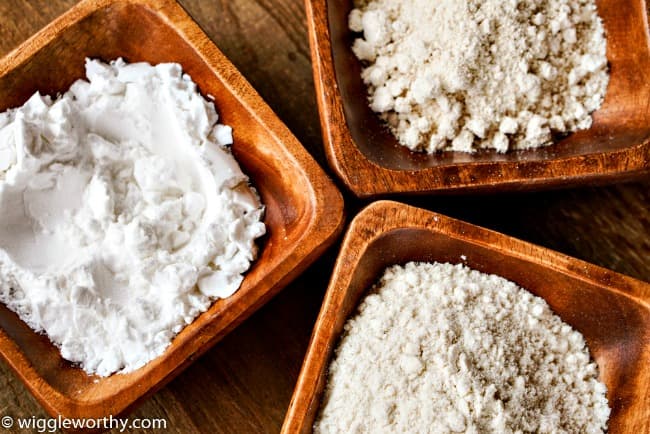
Whole grain gluten free flour blend for dog treats
For this blend I use a 7:3 ratio of whole grain to white flours/starches
You can also look at this from a percentage point of view where you'll use 70% whole grain flours and 30% white/starch in your whole grain gluten free flour blend.
For example, if your recipe calls for 2 1/2 cups of whole grain wheat flour, one option you could use to replace that would be:
- 1 3/4 cups oat flour
- 3/4 cup tapioca starch
If you do the math you'll see that:
- 1 3/4 cups is 70% of the total 2 1/2 cups, and 3/4 cup is 30% of that same total
- There are seven quarter-cup measures in 1 3/4 cups of flour and three quarter-cup measures in 3/4 cups of flour, so there's your 7:3 ratio
All purpose gluten free flour blend for dog treats
For this blend I use a 2:3 ratio of whole grain to white flour/starches.
As above, if your recipe calls for 2 1/2 cups of all purpose flour you could replace it with:
- 1 cup oat flour
- 1 1/2 cups tapioca starch
Again, doing the math you'll see that:
- 1 cup is 40% of the total 2 1/2 cups, and 1 1/2 cups is 60% of that same total
- There are two half-cup measures in 1 cup of flour and three half-cup measures in 1 1/2 cups of flour, there is your 2:3 ratio
It will take a little bit of trial and error and experimentation to find out which blend works best in any specific dog treat recipe but all of these should turn out acceptable results when used to replace a wheat flour in a 1:1 ratio.
Mix & Match Flours Within Each Category
I hope you're still with me because there's one more step that allows you to create an almost endless variety of gluten free flour blends....
As long as you keep to the percentage/ratio of flour from each category you can mix and match within them.
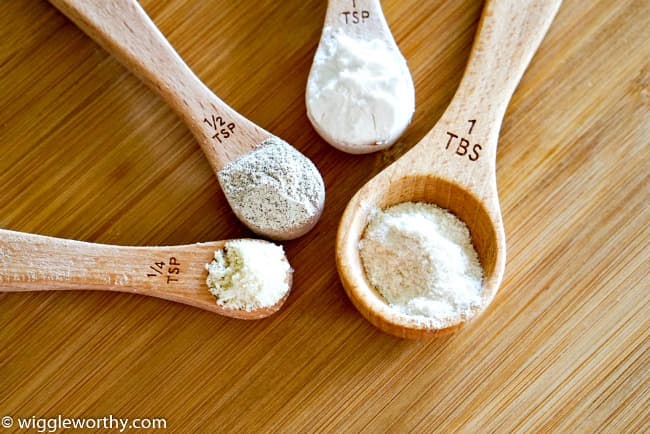
For example in your whole wheat GF blend:
Instead of using 1 3/4 cups of oat flour you could use 1 cup of oat flour and 3/4 cups of brown rice flour. As long as you have the same measure per category it's still 70% of the total.
You could also use 1/2 cup arrowroot flour and 1/4 cup of tapioca starch in the same recipe. Again, the total measurement for flour in that category is 30% of the total.
The end result of your substitutions for 2 1/2 cups of whole wheat flour could look like:
- 1 cup oat flour
- 3/4 cups brown rice flour
- 1/2 cup arrowroot flour
- 1/4 cup tapioca starch
So, endless possibilities. Wonderful isn't it?
Adding Binders to Gluten Free Flour Blends
If you're new to gluten free baking and the way in which gluten free flours act within a recipe you probably don't know that GF flours don't bind (hold together) the other ingredients the same way that wheat flours do. This is because it's the gluten itself which does the binding.
This isn't a problem in recipes which have been specifically designed to use gluten free flours because those have the other ingredients already allow for this.
But, if you want to substitute a dog treat gluten free flour blend for wheat flour in an existing recipe you may need to add a binding agent, or at the very least make some adjustments to the other ingredients, or balance of ingredients.
The simplest way to take care of this is to add one of several binding ingredients to your flour mix. Your options are:
- Xanthan Gum
- Guar Gum
- Ground flax seeds
- Ground chia seeds
- Psyllium husk
Many ready-made gluten free flour mixes will contain one of these, most likely xanthan gum.
What is Xanthan Gum and how do I use it?
Xanthan gum is a mixture of sugars and bacteria which produce a thickening and binding substance through a process of fermentation. It's widely known as a food additive but it’s also used in a whole variety of other products (including cosmetics, medications and industrial fluids) due it its viscose consistency and stabilizing properties.
Xanthan gum has no real nutritional value but is considered to be safe for consumption (by both people and animals) and has been studied as a food additive since the 1970’s. More recently there have been studies which indicate that it may even have health benefits including being able to slow down melanoma tumor growth and help people who have difficulty swallowing food or liquids.
However, it can cause gas, bloating and loose stools in some people, and some dogs, so if you notice extra flatulence or a funny-tummy in your dog after feeding him a new batch of gluten-free treats that contained Xanthan gum, that could be the problem.
Of course, we only give treats sparingly (because they’re TREATS after all, not food) so this is unlikely to be a problem except for super-sensitive dogs.
If you add about ¼ tsp of xanthan gum per cup of flour in your recipe you should get a reasonable mimicking of the natural binding process.
Alternatives to Xanthan gum in GF flour mixes
Guar Gum
Guar gum is a natural seed gum and is extracted from Guar beans.
It can be substituted for xanthan gum but in my opinion it’s not any healthier, and it is known to cause similar digestive issues (such as gas and bloating).
Chia Seeds & Flax Seeds
Personally I prefer all of my recipe ingredients to be valuable and nutritious and although I do use Xanthan gum from time to time I prefer to use either ground chia seeds or ground flax seeds as flour additives for gluten free baking.
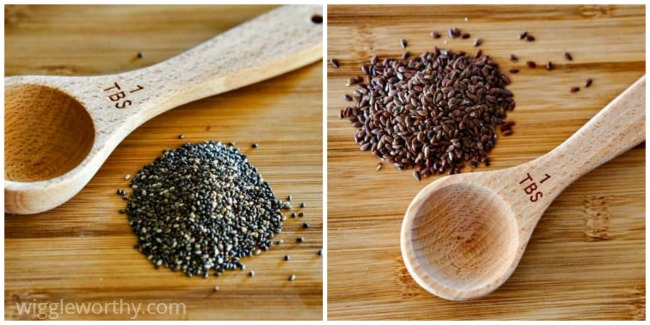
They are both superfood, plant-based ingredients so have a lot to bring to the table (literally!). Chia is a little more powerful than flax seed in the binding department but they’re pretty much interchangeable when you’re using small amounts. Buy ground seeds or use a mortar and pestle or coffee grinder to do grind whole seeds.
You can do this in two ways. You can simply replace approx. ¼ cup of the total flour in a recipe with ground flax or ground chia seeds.
If you want to substitute it in a gluten free flour mix or recipe that already includes xanthan gum, you can either replace it with the same amount of ground flax or chia seeds or do this:
Take however much xanthan gum the recipe calls for and replace it with either whole or ground chia seeds or ground flax seed but before adding it to the ingredients soak the seeds in water the way you would when making a chia or flax egg, because essentially that's what you're doing.
Flax seeds or chia 'eggs' can be used instead of one (maximum two) eggs in a recipe, which is useful to know if your dog doesn’t tolerate egg in his diet.
Psyllium Husk Powder
Finally, there’s one other option for adding some binding to your gluten free recipes and that’s powdered psyllium husk powder. This high fiber powder made from the outer layer of seeds from the psyllium plant. It doesn’t have the same nutritional value but works in a similar way to ground chia seeds or flax seeds as it absorbs water to become a thick jelly.
Psyllium husk is the main ingredient in some popular fiber supplements and can have a laxative effect so I prefer to stick with the chia and flax seeds but feel free to try all options you’re comfortable with and find what works for you!
Ready made gluten free flour blends...
What if you want to use a gluten free flour mix but don’t want to go to the time and trouble of making it yourself? Well, that’s easy because there are several great ready-made gluten free flour blends that you can buy either in your local grocery store or online.
While it's easier to find gluten free alternatives that all-purpose flour, you can find whole-wheat flour replacements too. I like Namaste Foods organic GF flours, they have both types of substitutes. Arrowhead Hills organic all-purpose flour blend is also excellent.
You can even find gluten free blends which incorporate nut flours, or nut and bean flours, which gives you even more variety of taste and nutrients in your recipes.
You Might Also Like These pages...
- Home
- Dog Treat Ingredients
- Dog Treat Gluten Free Flour Blend
- Home
- Baking Substitutions for Dog Treat Recipes
- Dog Treat Gluten Free Flour Blend
